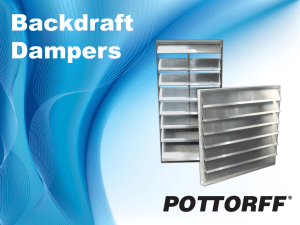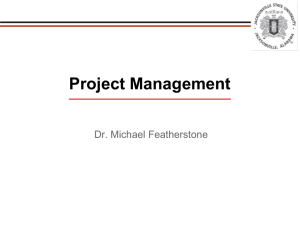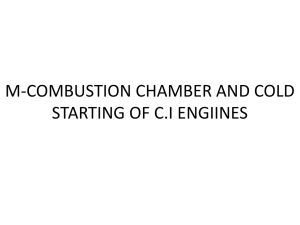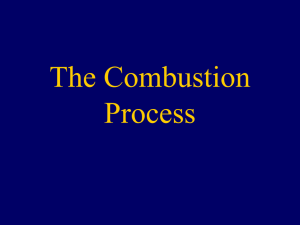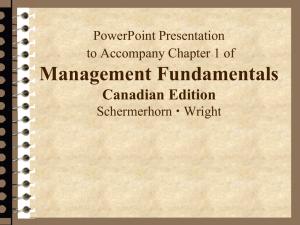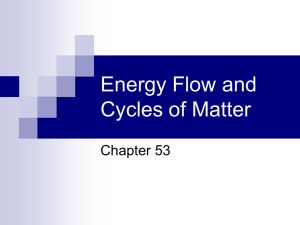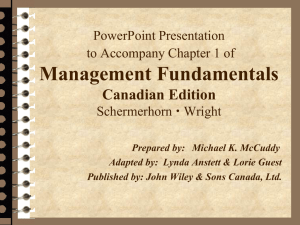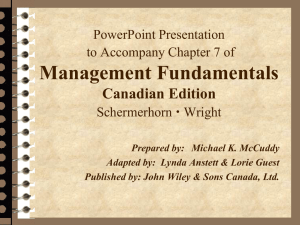Combustion fundamentals of fire Don`t do the crime if you can`t do
advertisement
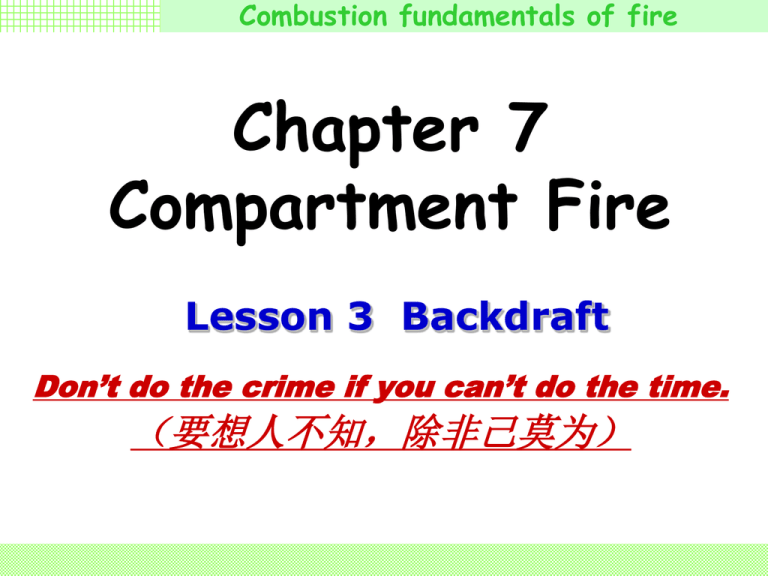
Combustion fundamentals of fire Chapter 7 Compartment Fire Lesson 3 Backdraft Don’t do the crime if you can’t do the time. (要想人不知,除非己莫为) Combustion fundamentals of fire content 1. Definition of backdraft 2. Formation of backdraft 3. Necessary Conditions for Backdraft 4. Consequences of Backdraft 5. Warning Signs of Backdraft 6. Preventing Death and Injury 7. Differences between Backdraft and flashover. Combustion fundamentals of fire Snippet from the film of LADDER 49 Combustion fundamentals of fire 1. Definition of Backdraft Definition from NFPA: The explosive or rapid burning of heated gases that occurs when oxygen is introduced into a building that has not been properly ventilated and has a depleted supply of oxygen due to fire. insufficiency Other definition from IFE (Institution of Fire Engineers) : An explosion of greater or lesser degree, caused by the inrush of fresh air from any source or cause, into a burning building, where combustion has been taking place in a shortage of air. Combustion fundamentals of fire A Basic Scenario想象 Limited ventilation can lead to a fire in a compartment producing fire gases containing significant proportions of partial combustion products and un-burnt pyrolysis products, which are all combustible. If these accumulate then the admission of air when an opening is made to the compartment can lead to a sudden deflagration. This deflagration moving through the compartment and out of the opening is BACKDRAFT. Combustion fundamentals of fire 2. Formation of Backdraft (1) A fire burning in a room with poor ventilation (2) Accumulation of flammable gases (3) Air introduction at the breaking of openings (4) Formation of mixture within flammability limits (5) Ignition of the mixture (6) Explosion or deflagration ,pressure rise Combustion fundamentals of fire 3.Necessary Conditions for Backdraft (1) The accumulation of smoke consisting of un-burnt pyrolyzates AND incomplete combustion products in a poorly ventilated compartment. (2) Air introduction when windows or doors are opened or broken. (3) The newly formed mixture of air and flammable smoke is within its flammability limits. (4) An ignition source of sufficient energy such as a flame, spark or glowing ember (余火). It is also possible for super-heated gases to ignite (auto-ignition), without a source of ignition being introduced. Combustion fundamentals of fire content 1. Definition of backdraft 2. Formation of backdraft 3. Necessary Conditions for Backdraft 4. Consequences of Backdraft 5. Warning Signs of Backdraft 6. Preventing Death and Injury 7. Differences between Backdraft and flashover. Combustion fundamentals of fire 4. Consequences of Backdraft Pressure Death and injure especially firefighters Properties Great damage Building structure Combustion fundamentals of fire 4. Consequences of Backdraft 4.1 Pressure Pressure rise because backdraft will force the burning gases in the compartment out through the openings with a high velocity, possibly igniting some of the unburned pyrolyzates that had be left in the compartment. This can create a significant fire-ball outside the compartment. Combustion fundamentals of fire Combustion fundamentals of fire 4. Consequences of Backdraft 4.2 Death and injure Explosions kill and injure firefighters in several ways. The blast (爆炸) can blow a firefighter across a street; flying glass and shrapnel (碎片) can decapitate (斩首) a firefighter. Combustion fundamentals of fire 4. Consequences of Backdraft 4.3 Great damage Flame accompanying the explosion can cause serious burns, collapse walls, partition and iron shutters (卷帘铁门) and crush firefighters beneath them. Combustion fundamentals of fire 4. Consequences of Backdraft Pressure Death and injure especially firefighters Properties Great damage Building structure Combustion fundamentals of fire 5. Warning Signs of Backdraft Outside the room Inside the room Combustion fundamentals of fire 5. Warning Signs of Backdraft 4.1 Outside the room Before opening a door or window to the compartment, the firefighter should be aware of: (1) A fire in a compartment with few openings has been burning for a long time. (2) Oily deposits on windows. (3) (跳动的) Pulsating smoke from openings. (4) Hot doors and door handles (windows). Combustion fundamentals of fire 5. Warning Signs of Backdraft 4.2 Inside the room (1) Blue flames (‘ghosting’ or ‘dancing’ flames) in the hot gas layer. (2) Smoke drawn back through opening. (3) Whistling and roaring sounds. It may be an indication that a backdraft is in progress(进行), there is probably little action that can be taken by a firefighter to prevent it. Combustion fundamentals of fire Smoke Drawn Back through the Door Combustion fundamentals of fire Backdraft is very dangerous, Firefighters should know that explosions happen fast, sometimes too fast for firefighters to take cover and protect themselves. Full protective gear: helmets(头盔) fire water branch hoods(防护帽) gloves(手套) coat bunker pants (防护裤) boots(长靴) Combustion fundamentals of fire Backdraft is very dangerous, Firefighters should know that explosions happen fast, sometimes too fast for firefighters to take cover and protect themselves. Full protective gear: Protective fire gear may be hot, cumbersome (笨重的) and slow you down, but if you were caught in an explosion, it may protect you survive from the blast and not be hurt hardly. Combustion fundamentals of fire The Peru (秘鲁) firefighters force entry just prior to the backdraft Amazing Peru Backdraft! The Aftermath (后期)!!! An exterior defensive operation is mounted following the backdraft. Combustion fundamentals of fire content 1. Definition of backdraft 2. Formation of backdraft 3. Necessary Conditions for Backdraft 4. Consequences of Backdraft 5. Warning Signs of Backdraft 6. Preventing Death and Injury 7. Differences between Backdraft and flashover. Combustion fundamentals of fire 6. Preventing Death and Injury There are three tactics(战术) that can reduce the chances of getting caught in a backdraft: 6.1 Venting (通风) 6.2 Quenching (熄灭) 6.3 Flanking (侧翼攻击) Combustion fundamentals of fire 6. Preventing Death and Injury 6.1 Venting Venting a roof skylight (天窗) over a burning room is one of the most effective method to protect firefighters from the blast of the backdraft. (1) When roof conditions permit, the quick removal of the skylight can vent smoke-filled room and break up the explosive mixture. (2) Even if the smoke explosion occurs, the blast will be diverted(转移) upward and out of the room from the opening, and be away from the firefighters advancing the hose-line. Combustion fundamentals of fire 6. Preventing Death and Injury 6.2 Quenching Before entering a superheated confined room, charged hose-line (fire water branch) should be positioned near the entrance. Firefighters in full protective equipment should immediately discharge (射水) a hose stream into a fire area when it is opened up. (1)The water can cool a potential and explosive atmosphere. (2)The powerful water stream might break up the explosive atmosphere. Combustion fundamentals of fire Firefighters in Australia get to grips with an 'entry & attack-module' trainer. Combustion fundamentals of fire 6. Preventing Death and Injury 6.3 Flanking When venting and quenching are impossible, the officer in command can order two hose-lines into position, one on each side of a door or window of the burning room. After the hose lines are charged with water and firefighters are in full protective equipment, the door or window is broken. Both flanking hose lines, safely out of the path of any potential explosive blast coming out of the opening, can be directed into the burning room. Combustion fundamentals of fire Tactical Firefighting Training Training in other aspects Staffordshire County firefighters (UK) training with a backdraft demonstrator (示范装置) Combustion fundamentals of fire 7. Differences between Backdraft and flashover There are FOUR main differences: 7.1 Backdraft is an explosion, flashover is a transition. There will be shock waves (冲击波) during backdraft fire, which will break the confining structure and windows around the explosion; blasts of smoke and flame may blow out a doorway; part of the structure may collapse. Flashover is rapid fire development, but without the speed of explosion of the chemical reaction. Combustion fundamentals of fire 7. Differences between Backdraft and flashover There are FOUR main differences: 7.2 backdraft does not happen as often as flashover does. You may experience only one or two backdraft during your entire career. But flashover happens often (flame suddenly full the whole room). You will probably face flashover again next time. Combustion fundamentals of fire 7. Differences between Backdraft and flashover There are FOUR main differences: 7.3 The triggering or cause of them are different. Basic scientific definitions of flashover and backdraft suggest that flashover is primarily "heat induced" whilst backdraft is "ventilation induced". Combustion fundamentals of fire 7. Differences between Backdraft and flashover There are FOUR main differences: 7.3 The triggering or cause of them are different. backdraft is "ventilation induced". Air introduction sets off the backdraft explosion. As firefighters enter a confined smoke-filled area and bring fresh air with them, sometimes a backdraft or smoke explosion happens. Combustion fundamentals of fire 7. Differences between Backdraft and flashover There are FOUR main differences: 7.3 The triggering or cause of them are different. flashover is primarily “ heat induced“. The trigger of a flashover is heat. The theory of flashover is heat, which raises the temperature of the gases and furnishings in the room to the auto-ignition temperature and triggers a flashover. Combustion fundamentals of fire 7. Differences between Backdraft and flashover There are FOUR main differences: 7.3 The triggering or cause of them are different. Page301 The last paragraph Combustion fundamentals of fire 7. Differences between Backdraft and flashover There are FOUR main differences: 7.4 Flashover and backdraft occours at different stage. Backdraft explosions occur during the first and the third stages of fire, when the combustible smoke is in a confined space. During the growth and decay stages, smoldering can take place and generate explosive gas such as CO (carbon monoxide). Combustion fundamentals of fire 7. Differences between Backdraft and flashover There are FOUR main differences: 7.4 Flashover and backdraft occours at different stage. On the other hand, flashover is the transition of and , so it only occurs between the two stages, it signals the end of the growth stage. Combustion fundamentals of fire Flashover or Backdraft? Extension Reading Extreme Fire Behavior Modelling Modelling of FLASHOVER and BACKDRAFT Using Fire Field Models Combustion fundamentals of fire Combustion fundamentals of fire Combustion fundamentals of fire Combustion fundamentals of fire Combustion fundamentals of fire A Backdraft Case The backdraft that blew apart an Illinois church(伊利诺斯州教堂) on February 9th, 2004 has been named the largest backdraft ever documented in the U.S. Combustion fundamentals of fire The firefighters determined it was too hot and smokey to enter the church basement, so they opened the ground level windows. The door to the basement felt cold but suddenly blew out when the backdraft occurred. Combustion fundamentals of fire Riddle was in his command vehicle (消防指挥车) when the backdraft occurred. “I heard the noise and I looked up... the piece of the roof was being removed - it went up about 10 feet and then came back down.” he said. There was no warning except that immediately before the blast, “The guys on the scene said they heard a sucking sound.” Riddle said. Combustion fundamentals of fire The backdraft blew the roof off the Church and knocked flat eight firefighters on scene and two firefighters were injured. A firefighter who had felt the door suffered burns to his hand because he had taken his glove off. Another firefighter was blown out of the cab of the engine, and another was blown across an alley. Study the case in detail Combustion fundamentals of fire Summary 1. Definition of backdraft 2. Formation of backdraft 3. Necessary Conditions for Backdraft 4. Consequences of Backdraft 5. Warning Signs of Backdraft 6. Preventing Death and Injury 7. Differences between Backdraft and flashover. Combustion fundamentals of fire Homework 1. What are the warning signs of a backdraft? 2. What are the three firefighting tactics that can reduce destructive effects of a backdraft explosion? 3. What are the differences between a backdraft and flashover? Combustion fundamentals of fire
